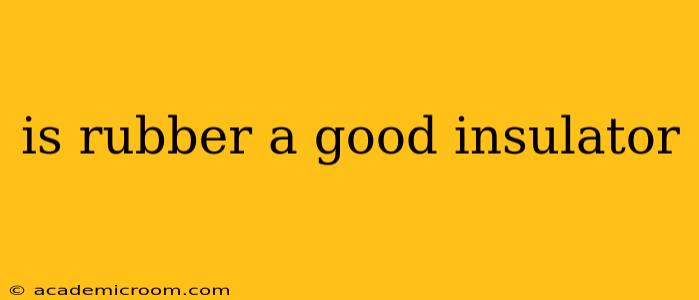Rubber's insulating properties are a complex topic, often misunderstood. While it's commonly used as an insulator, its effectiveness depends significantly on several factors. This comprehensive guide will delve into the nuances of rubber as an insulator, answering common questions and providing a clear understanding of its applications.
What Types of Rubber Are Used as Insulators?
Not all rubbers are created equal when it comes to insulation. The type of rubber significantly impacts its insulating capabilities. Commonly used insulating rubbers include:
- Natural Rubber: Possesses good dielectric strength but can be susceptible to degradation from heat and ozone.
- Ethylene Propylene Rubber (EPR): Offers excellent resistance to heat, ozone, and chemicals, making it ideal for high-temperature applications.
- Silicone Rubber: Excels in high-temperature and low-temperature environments, maintaining flexibility over a broad temperature range.
- Neoprene (Polychloroprene): Known for its resistance to oils, chemicals, and weathering, making it suitable for outdoor applications.
- Butyl Rubber: Provides excellent resistance to moisture and gases, often used in applications requiring hermetic sealing.
How Good is Rubber as an Electrical Insulator?
Rubber's electrical insulating properties are characterized by its high dielectric strength, meaning it can withstand high voltages without breaking down. However, the actual performance varies greatly based on:
- Type of Rubber: As discussed above, different rubber types exhibit varying dielectric strengths and resistance to environmental factors.
- Temperature: Extreme temperatures can affect the insulating properties of rubber, potentially leading to degradation and reduced effectiveness.
- Frequency: The insulating properties of rubber can change depending on the frequency of the electrical current.
- Thickness: A thicker layer of rubber provides better insulation than a thinner layer.
- Age and Condition: Over time, rubber can degrade due to exposure to ozone, UV radiation, and chemicals, compromising its insulating capabilities.
What are the Applications of Rubber as an Insulator?
Rubber's versatility as an insulator leads to its use in a wide range of applications, including:
- Electrical Wiring: Rubber insulation is crucial in protecting electrical wires and cables from short circuits and electrical shocks.
- Automotive Parts: Used in various automotive components to prevent electrical shorts and protect against vibration.
- Appliances: Found in many household appliances to insulate electrical components and ensure safety.
- High-Voltage Applications: Specific rubber types with high dielectric strength are employed in high-voltage applications, like power cables.
Is Rubber a Good Thermal Insulator?
While primarily known for its electrical insulating properties, rubber also exhibits some thermal insulating capabilities. However, it's not as effective a thermal insulator as materials like fiberglass or foam. Its thermal insulation properties are more significant in preventing heat transfer in certain applications, not as a primary thermal barrier.
How Does Rubber Insulation Compare to Other Insulating Materials?
Rubber's position in the insulating materials landscape is niche. While effective in many electrical applications, it doesn't necessarily outperform other materials in all cases. For example, materials like PTFE (polytetrafluoroethylene) offer superior chemical resistance and dielectric strength in specific high-performance applications. The best insulator depends heavily on the specific application's requirements.
What are the Limitations of Rubber as an Insulator?
Despite its advantages, rubber insulation has limitations:
- Susceptibility to Degradation: Exposure to sunlight, ozone, and chemicals can degrade rubber over time, reducing its insulating effectiveness.
- Temperature Sensitivity: Extreme temperatures can affect rubber's properties, potentially compromising its insulation.
- Not Ideal for All Applications: Rubber may not be the optimal choice for high-frequency applications or environments with extreme chemical exposure.
This detailed exploration should provide a comprehensive understanding of rubber's role as an insulator. Remember that choosing the right type of rubber and understanding its limitations are crucial for ensuring effective and safe insulation in any application.
